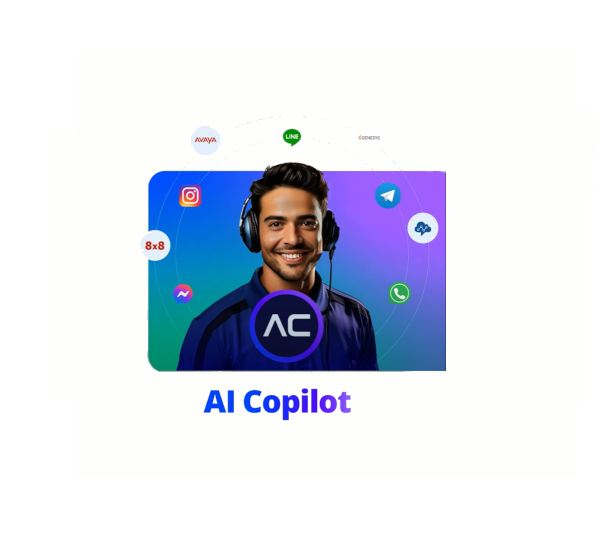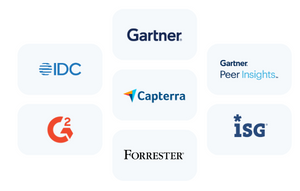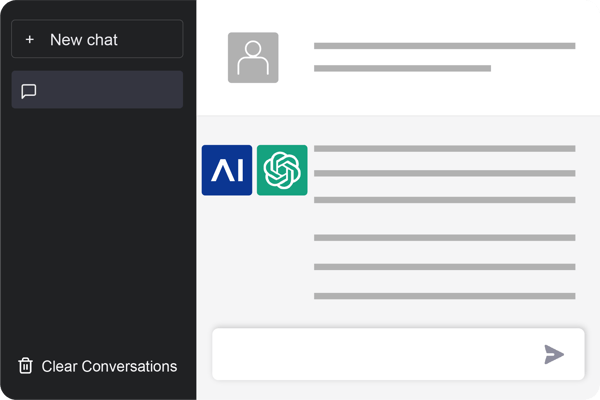Healthcare contact centers play a critical role in managing the rising burden of patient demand faced by healthcare providers. They are responsible for assisting patients, whether through offering advice and guidance or by answering direct queries.
Across the entire healthcare sector, the weight of patient demand must be balanced against costs and available resources. The more cases your contact center wants to resolve, the more employees you have to hire, train, and deploy.
Unless, of course, you invest in automation.
Healthcare automation is a growing trend, with the total market share valued at $42.59 billion in 2024 and set to grow to $110.47 billion by 2034. Automation can be seen in many forms within healthcare, whether that’s through digital tools designed to speed up laborious administrative tasks like billing or appointment reminders, or in more direct care scenarios leveraging robotics to assist in monitoring or treatment.
AI Agents for healthcare contact centers help you more effectively resolve an ever-increasing number of customer interactions without the associated increase in resource demand and subsequently, costs. In this guide, we’ll explore automation within the healthcare industry and see how it can best support your team.
What Is Healthcare Contact Center Automation?
Automation is the process of reducing human input by using technology that can automatically carry out certain tasks. Recent developments in Artificial Intelligence (AI) have made automation far more flexible and valuable to businesses by allowing for the automation of customer conversations and important customer service processes.
Every contact center is different, and what you choose to automate will depend on your most common problems. Healthcare companies may benefit from automating processes such as:
- Patient requests: Implementing an AI Voice Agent to engage in conversations with users means you can automate part (or all) of a customer’s service call. The agent can answer the call to cut out waiting times and begin fielding the query, before it then either routes the call to a human agent or, if the case is a simple request, carry it out without any need for human intervention.
- Appointment reminders: Contact centers that deal with patient appointments can dramatically reduce manual admin by introducing an automated AI Agent that doesn’t just remind patients of upcoming appointments – but also allows them to reschedule them without having to speak to a human.
- Billing & payments: AI-driven automation can proactively notify customers about upcoming bills and send payment reminders. It can also provide a payment link within the same interaction, reducing friction to protect revenue. After payment, the AI Agent can generate invoices or receipts and automatically send them to customers – further reducing the burden on human agents.
These examples are only basic ideas to help you understand the capabilities of automation. It is, however, in these more straightforward, high-volume tasks where automation offers the most value by reducing human workload and allowing you to be far more resource-efficient.
How Do You Automate Healthcare Contact Centers?
Successful automation is about understanding which processes are best served by technology rather than human intervention. Until very recently, a contact center could only achieve partial automation by implementing tools like chatbots to help take care of a specific, pre-defined customer need.
Now, however, the capabilities of AI mean that automation can be more comprehensive and span multiple processes. An automated agent that utilizes both Conversational AI and Generative AI can understand a customer’s query, identify context, engage in conversation with the customer, and then either resolve the task or route it to a human. If you’d like to learn more about how CAI works, you can read our guide to Conversational AI in Healthcare.
This ultimately means that the ‘how’ of automation comes down to the approach – how do you best identify the processes and tasks an AI Agent can best help you accomplish? The answer lies in starting with a narrow task and scaling out from there…
- Identify use case: Start with a low-complexity, highly repeatable task that takes up lots of time. For healthcare contact centers, the ID&V process is often the best starting point, as it is necessary at the onset of every call.
- Consider customer flow: Within your target use case, what is the desired outcome you want to reach, and how can you best support customers in reaching it? What steps do you need to take a customer through, what tools or technology are involved, and what resources do they require?
- Apply automation: With your desired outcome in mind, you can implement an AI Agent that can field customer cases and carry out actions autonomously. This agent will be pre-trained on terms and topics related to healthcare so it can immediately understand the context of a user’s problem and automatically progress towards a satisfactory outcome – whether that’s achieved by the AI Agent or by routing to a human.
- Review and improve: Once you have automation in place, you can begin monitoring results. Cognigy.AI offers insights that make your data more compelling, measuring things like customer sentiment and identifying specific moments of friction. Use this data to tweak processes, improve human agent utilization, and decrease customer frustration.
What Are the Benefits of Contact Center Automation in Healthcare?
The main benefit of automation is to improve efficiency – which in turn decreases costs, improves agent productivity, and increases the likelihood of positive outcomes. In the healthcare sector, automation offers some additional benefits tailored specifically to patient requirements. Here are some of the most compelling…
Increased Efficiency
Automation’s most obvious benefit is in improving overall efficiency within a contact center. By reducing the burden of repeatable, low-complexity tasks, AI Agents allow you to cut down on Average Handling Times (AHT) across your main customer service processes. In many cases, just automating the initial stages of a customer contact call will save as much as 30 seconds per call – which adds up to an incredible amount of time saved over a year.
24/7 Availability & Omnichannel Support
Patients don’t want to wait when they contact customer support. In healthcare, this can mean being stuck in a long hold queue or even just being forced to navigate department extensions trying to find the right team. AI Agent automation means you can answer calls instantly, and the AI will begin conversing with the customer, which makes your automation far more engaging than a rigid IVR menu.
As customers become more reliant on multiple channels for communication, they expect contact centers to cater to them. Using AI Agents to achieve automation means you can also support conversations across many different channels such as WhatsApp, webchat, email, SMS, and voice calls.
More Productive Human Agents
Automation isn’t about replacing your workforce – it’s about augmenting them. Take, for example, pharmacies that utilize robots to help pick and package prescriptions to make human dispensing roles more effective.
In much the same way, an automated AI Agent working in a contact center takes care of the more mundane aspects of a call so that human agents can focus their time on complex cases.
You can also utilize AI Agent Assist to offer direct support to your human team, assisting them during a call by transcribing the conversation, translating where required, and generating answers to questions as they happen.
Personalized Patient Interaction
The concept of automation is inherently impersonal – it takes the ‘human’ out of the process. However, the evolution of AI technology means you can automate whilst retaining personalization and giving patients a sense of one-to-one, supportive care. In the healthcare sector, where reassurance and trust are enormously important, the benefits of AI Agents that can display sympathy and help alleviate a patient’s worries during a call are highly compelling.
Cost Savings
Increased efficiency and less reliance on human teams for basic customer queries mean you’ll be able to handle higher call volumes without the associated increase in labor – which means reducing your costs even as you scale. AI Agent automation can also help protect revenue by improving cost-related processes like notifying patients of upcoming renewals or automatically sending payment prompts.
Engaging Self-Service
One of the most important areas of automation is in facilitating self-service options that allow customers to carry out tasks themselves without having to rely on a customer service representative or clinician. AI Agents can be used as an intuitive self-service option, allowing patients to carry out basic tasks such as updating personal details or scheduling appointments without having to speak to a human agent.
Healthcare contact centers that use automated AI Agents to implement better self-service will reduce patient demand and subsequently free up even more time to focus on complex cases.
Better Patient Experiences
For general customer service queries, the main thing customers want is to have problems solved quickly. But in healthcare, where additional stressors are in place, patients also want to feel valued and supported. An AI Agent combines all of the benefits of automation (zero waiting times, increased resolution speed, and omnichannel capabilities) and also provides a more intuitive, personalized interface with a customer.
With access to previous call history and CRM data, an AI Agent can avoid asking repetitive questions and can focus on progressing the case. If it detects a change in sentiment, it can take the appropriate action.
All of these things combine to mean that automation using AI Agents drives a better patient experience that is far more likely to lead to a positive outcome despite far lower AHTs.
Use Cases of Contact Center Automation in Healthcare
To really understand the value of automation and how to implement it within your healthcare contact center, you need to look at appropriate use cases that show exactly what can be automated and how it helps. These use cases are all based on real customer journeys handled by contact centers in the healthcare sector:
Verifying Patient Information
Healthcare is a heavily regulated sector where collecting and storing patient information is an incredibly sensitive matter. You can implement an automated AI Agent responsible for taking a patient’s call and extracting this important information, verifying it against your back-end systems, and then connecting them to a human team or progressing the case on its own.
The AI Agent, though flexible and able to communicate in a human-like manner, is still dependent on the parameters you give it – so it will protect customer data and act in compliance with any rules you need it to.
Appointment Scheduling and Reminders
One of the most common customer frustrations in the healthcare sector stems from missed appointments. Automation helps you give customers more control over their appointments, allowing them to call an AI Agent and reschedule at a time more convenient to them – all without having to wait on hold.
This type of automation is going to be critical for healthcare sectors, where missed appointments can cost millions of dollars every year. A UK study2 found that patients who were allowed to reschedule their own appointments were less likely to miss them when compared to those whose appointments were managed solely by clinics.
Automating the scheduling of reminders is only one side of the process – you can also use proactive automation to send reminders to patients ahead of the appointment. If the patient can’t attend, they can then talk to the AI Agent to cancel or reschedule it.
Prescription Requests
Automation can be used to streamline prescription requests – reducing the need for human agent involvement when gathering the necessary information and then allowing clinicians to review the request and issue the prescription quickly.
Patient monitoring
Healthcare technology continues to evolve at a rapid rate. Wearable technology allows healthcare organizations to provide proactive monitoring services to clients. Contact centers can design AI Agents responsible for monitoring patient data and issuing automated notifications and guidance to help improve patient health.
FAQ & Query Bot
In most contact centers, even in a sector like healthcare, there are common queries that burden your teams despite being easy to answer.
Automation is an incredible way to address these FAQs without making customers feel like they’re being sent away to an FAQ page on your website. The AI Agent can simply talk to the user, identify their question, and then find the appropriate answer – all without having to ask the customer to navigate to a specific page or take any other actions.
Examples of Contact Center Automation in Healthcare
Potential use cases are one thing – but real-world examples help show you exactly how automation can be used in healthcare to improve patient experiences and reduce costs…
Health and wellbeing platform automates member queries
Healthcare brand Virgin Pulse wanted to improve self-service options for its members, many of whom sought answers to commonly asked questions. Working with Cognigy, Virgin Pulse developed an automated AI Agent that was responsible for quickly resolving FAQ-style queries by sourcing answers from the Zendesk help center.
The automation proved highly successful in resolving common queries without any human involvement, achieving a 40% containment rate in a single month. To make that clear, 40% of user queries are fully solved within the automated interaction, which means less demand on human agents and reduced costs. Read more about this case study here.
Internal comms made more engaging via automated AI Agent
When Bayer was moving to a new model named dynamic shared ownership (DSO), its management team knew that employees would have plenty of questions. In addition to providing new material for them to review, Bayer also created an internal AI Agent that could field queries more engagingly and intuitively, allowing employees to ask freeform questions and find the right answers. This helped prevent information overload and gave employees the information they needed exactly when they needed it.
The agent is multilingual and can serve a user base of approximately 19,000 employees across Bayer’s various operating regions, who can access it via Microsoft Teams, web chat, and SharePoint. Read more in the full case study.
Best Practices for Implementing Contact Center Automation in Healthcare
Start with High-Impact Areas
As we alluded to in the use case section, you should always start any efforts at automating with your most high-impact customer processes. These are the areas that take the most time but are the least complex. Start by automating these simple, repeatable processes and you’ll quickly see improvements, which you can then use to justify further automation and scale from there.
Think About The Customer First
Automation is one of the best ways to drive cost savings across your organization as it scales. However, every automation must be designed around genuine customer problems and processes. If you only automate based on top-level business goals and forget about how it impacts a customer, you’ll waste time and money.
Remember that the faster and more effectively a customer reaches their goal, the more efficient (and profitable) your contact center is – so prioritize automation and technology that facilitates that.
Focus on Compliance and Data Security
Healthcare is a heavily regulated industry, and all technology decisions need to be made with a full understanding of risk. Every process that you choose to automate will likely involve sensitive information – so you need to be sure any automation protects that data and complies with the rules of whichever governing bodies oversee healthcare operations in your country.
Audit Your Tech Stack
To automate using an AI Agent, you need to assess your existing technology stack to see how the agent can best integrate with critical systems and processes. In general, AI Agents act as a ‘top layer’ that sit above these tools and can interact with them when needed (for example, checking a customer’s information against their CRM entry).
Custom-coded software and bespoke solutions may not support automation, so you’ll need to gauge how disruptive any changes may be by talking to your tech team and your AI provider.
Train and Support Staff on New Technologies
Employees who fear automation may miss out on the benefits it can bring to their role. When they hear you’re bringing in a new technology to cut call times, they might feel as though they won’t be needed – so make sure you inform them of the changes and how they will change workflows to be more efficient and allow human agents to waste less time on mundane tasks.
Regularly Review and Optimize
Automation isn’t a case of sitting back and watching the results roll in. Like any business process, it should be monitored and improved upon. The benefit of AI Agents for automation is that the insights they gather can be used to fuel tangible future improvements – drawing on vast quantities of data from customer CRM data and conversation history.
Automation Is the Future of Contact Centers in the Healthcare Industry
If you’re serious about growth, you need to invest in automation as a matter of priority. Though robotics-led automation may be the priority for direct patient care, AI-led automation gives contact centers the flexibility, capacity, and efficiency needed to scale into the future.
Cognigy.AI is the perfect way to automate enterprise-level contact centers, providing powerful AI Agents that can engage your customers and revolutionize your service processes. Try a demo today and see it for yourself.
References
1: https://www.precedenceresearch.com/healthcare-automation-market
2: https://www.tandfonline.com/doi/full/10.1080/20479700.2023.2225760

.png?width=60&height=60&name=AI%20Copilot%20logo%20(mega%20menu).png)




.png?width=600&height=600&name=Knowledge%20AI%20Feature%20image%20(2).png)













